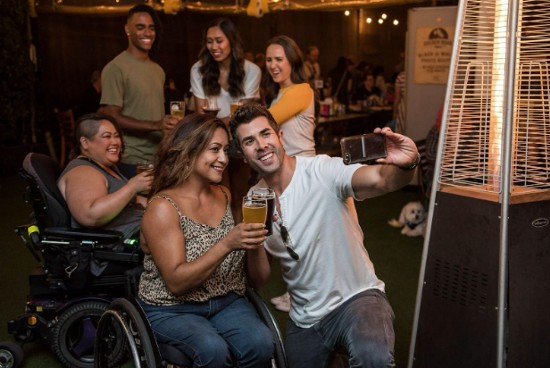
Katie Brenneman is always a welcome contributor to postings here at 21st Century Tech Blog. She is an Oregonian. She has written on a wide range of subjects. In this contribution, she looks at how technology is helping to level the playing field for people with disability.
Before posting Katie’s article, I sent it to my good friend, Dan Thompson. Dan has lived with quadriplegia since his teenage years when he severely damaged his spinal cord in a car accident. I asked Dan to review the article and he called it a good general overview.
Dan did tell me that his personal experience in using online booking for hotels has not always provided him with accessibility leaving him to sleep in his wheelchair. So as much as technology is making the playing field more level for those with disabilities, not everything works according to plan.
I hope you enjoy Katie’s contribution here and provide comments.
Millions of people around the world live with disabilities. So why is accessibility severely lacking? For instance, those in wheelchairs, and individuals who are blind or deaf continue to bring to light how self-checkout systems in stores cause them to struggle. And the Internet isn’t proving to be any more disability-friendly than stores. A WebAim report on accessibility of homepages recently revealed that “across the one million home pages, 50,829,406 distinct accessibility errors were detected—an average of 50.8 errors per page.”
In various industries, however, accessibility is improving. So let’s look at where and how the technology world is addressing accessibility.
The Metaverse
If unfamiliar with the metaverse, it’s a 3D-enabled digital space where people socialize, learn, and play by way of virtual reality (VR), augmented reality (AR), a high-speed internet connection (preferably 5G), and other high-tech tools. This space is contributing to increasing accessibility because those with various disabilities can enjoy it to experience what it is like to live without their disability.
Users with physical impairment can engage in the metaverse. For example, someone living with arthritis and chronic pain, which prevents them from being active, can create an avatar in the metaverse and engage with people all over the world without leaving home.
Individuals living with vision, hearing, and cognitive challenges can now use high-colour contrast choices, subtitles, captions generated in real-time, and 3D-audio echolocation to help them navigate the digital world. In this way, the metaverse is allowing people to be who they want to be, their authentic selves.
[Editor’s Note: When Dan and I were working together, we paid a visit to an early-stage augmented reality developer who allowed Dan to experience the feeling of walking through fall foliage with the dry leaves brushing his digital feet. He also was given wings to fly. That was happening well before Second Life, Facebook and now Meta.]
Assistive Tool Compatibility
“More than 2.5 billion people need one or more assistive products, such as wheelchairs, hearing aids, or apps that support communication and cognition,” according to the WHO-UNICEF Global Report on Assistive Technology (AT).
That’s a lot of people and a healthy market for technology companies to address. That’s why the industry is creating products that are compatible with the aids used by people living with specific disabilities. These include:
- Braille e-readers
- Voice assistants
- Assistive keyboards
- Text-to-speech systems
- Screen reading software
- Accessible Rich Internet Applications (ARIA)
- Word predictive software
A great example of this push for assistive device compatibility in the tech industry is The Speech Accessibility Project, a partnership that includes Amazon, Apple, Microsoft, Meta, Google, and the University of Illinois. They’re working to make voice recognition technology more useful for those with varying speech patterns and disabilities.
[Editor’s Note: Speech recognition is an area where I gained considerable experience, having worked on several projects in the early 1990s when the technology was in its infancy. That’s where I met Dan who used voice recognition to make it possible for him to work with computers.
Dan suggested that word prediction software which is a feature of G-mail and other e-mail systems, has been of great assisstance to people with disability who are challenged by computer keyboards. A feature that anticipates words that follow a word you type can dramatically speed up written communication for those with a disability which makes keyboarding a challenge. In addition, features like autocorrect in applications like Microsoft Word can be of considerable help.]
Advancements in Tourism
Tourism has been focused on accessibility longer than most other industries. The following list shows where improvements are being made.
- In-person accessibility – Airports, transportation services, hotels, and popular tourist destinations like theme parks today are more accessible than ever. These services and places provide physical, sensory, and communication access for the disabled including accessible restrooms, elevators, and wide doorways. Destinations use audio guides and sensory-sensitive lighting and sound systems to accommodate related disabilities. Staff members at tourist destinations and in many hotels are trained to be fluent in American Sign Language (ASL). A recent survey ranked Las Vegas, New York, and Orlando, Florida as the most disability-friendly cities in the United States. Many Las Vegas shows offer audio descriptions. New York businesses are implementing permanent and portable ramps. And Walt Disney World offers disability-accessible services which can be viewed on their Florida website.
- Travel, hotel, and hospitality websites – Many travel, hotel, and hospitality websites today prioritize guests with disabilities by providing accessible rooms that can be requested through online booking. Other features of these sites that make it easier for those with disabilities include:
- Simple navigation
- Text-to-speech readers
- Digestible content
- Easy access to customer service
- Enabled keyboard navigation
[Editor’s Note: I wonder how much artificial intelligence (AI) tools like ChatGPT will contribute to levelling the playing field for those with disabilities. I suspect it will happen sooner than later considering the rapid evolution of the technology. This would be a good subject for a future posting here at 21st Century Tech Blog.]




